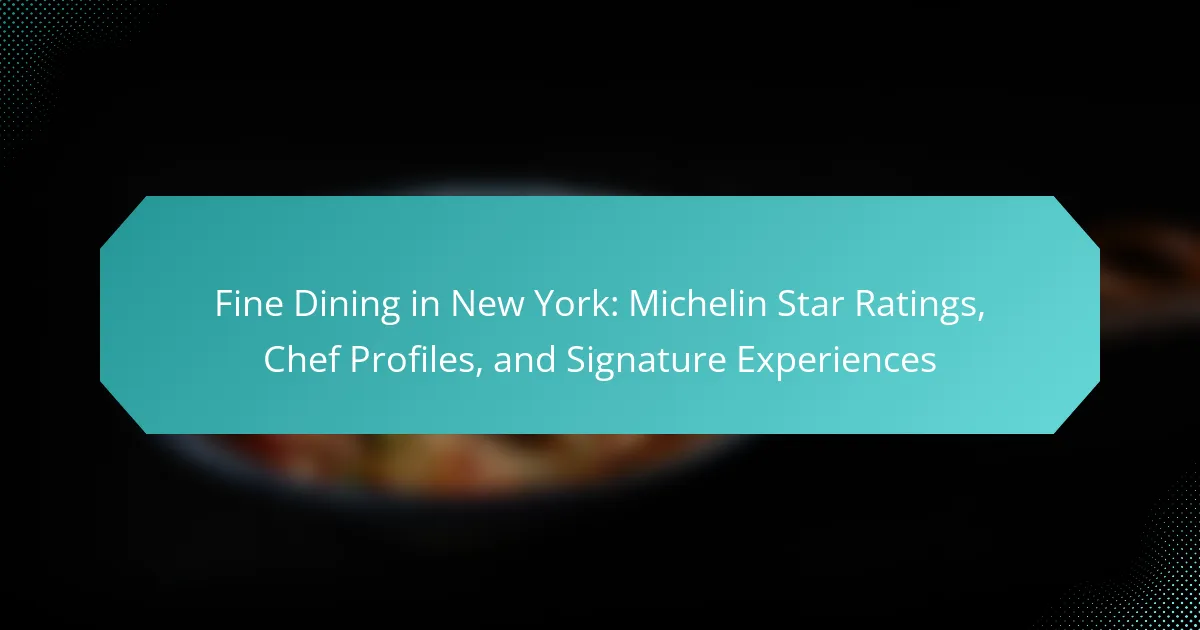Fine dining in New York is characterized by exceptional service, high-quality ingredients, and a refined atmosphere, with many restaurants featuring Michelin star ratings that signify culinary excellence. Notable chefs such as Daniel Boulud, Thomas Keller, and Jean-Georges Vongerichten play a significant role in shaping this vibrant culinary landscape, each offering unique dining experiences through their acclaimed establishments. Diners can enhance their experience by exploring chef profiles, signature dishes, and seasonal menus while adhering to proper dining etiquette. Reservations are essential at popular venues, and online platforms provide valuable reviews and ratings to assist in navigating the fine dining scene.

What defines fine dining in New York?
Fine dining in New York is defined by exceptional service, high-quality ingredients, and a refined atmosphere. Restaurants often feature meticulously crafted menus by renowned chefs. Many establishments hold Michelin star ratings, indicating their culinary excellence. The ambiance typically includes elegant decor and attentive staff. Unique dining experiences, such as chef’s tables or tasting menus, are common. Fine dining also emphasizes a curated wine selection to complement the meal. Reservations are often required, reflecting the exclusivity of the experience. Overall, fine dining in New York represents a blend of culinary artistry and sophisticated dining culture.
How is fine dining distinguished from other dining experiences?
Fine dining is distinguished from other dining experiences by its emphasis on high-quality ingredients, exceptional service, and a sophisticated atmosphere. The food often features intricate preparation and presentation. Fine dining establishments typically offer a curated menu, often created by renowned chefs. The dining experience is characterized by attention to detail, from table settings to wine pairings. Reservations are often required, and dress codes may be enforced. Fine dining restaurants may also have Michelin star ratings, which signify their excellence in cuisine and service. This level of recognition sets them apart from casual dining venues.
What are the key characteristics of fine dining establishments?
Fine dining establishments are characterized by high-quality food, exceptional service, and an elegant atmosphere. These restaurants often feature a carefully curated menu with gourmet dishes. The ingredients used are typically fresh, seasonal, and sourced from reputable suppliers. Service in fine dining is attentive and personalized, with staff trained to meet specific customer needs. The ambiance is usually sophisticated, often enhanced by upscale decor and table settings. Reservations are often required, and dress codes may be enforced. Many fine dining restaurants also offer wine pairings to complement the meal. These characteristics contribute to a memorable dining experience that goes beyond just the food.
How do ambiance and service contribute to fine dining?
Ambiance and service are critical elements that enhance the fine dining experience. Ambiance creates an inviting atmosphere through decor, lighting, and music. The right ambiance sets the mood for a memorable meal. Service plays a vital role in guest satisfaction. Attentive and knowledgeable staff elevate the dining experience. Studies show that exceptional service can increase customer loyalty and positive reviews. Fine dining establishments often invest in training staff to ensure high service standards. Together, ambiance and service contribute significantly to the overall perception of fine dining quality.
What role do Michelin star ratings play in fine dining?
Michelin star ratings serve as a prestigious benchmark in fine dining. They evaluate restaurants based on quality, creativity, and consistency. The rating system includes one to three stars, with three stars indicating exceptional cuisine. Receiving a Michelin star can significantly elevate a restaurant’s reputation. It often leads to increased customer interest and higher reservations. The Michelin Guide is recognized worldwide, making its ratings influential in the culinary industry. Many chefs aspire to earn these stars as a mark of excellence. The impact of Michelin stars can also affect a restaurant’s pricing and menu offerings.
How are Michelin stars awarded to restaurants?
Michelin stars are awarded to restaurants based on the quality of their food, service, and overall dining experience. Inspectors evaluate several factors, including the freshness of ingredients, mastery of techniques, and the harmony of flavors. Each restaurant is visited multiple times by anonymous inspectors. The Michelin Guide uses a standardized rating system of one to three stars. One star indicates a very good restaurant in its category. Two stars signify excellent cooking that is worth a detour. Three stars denote exceptional cuisine that is worth a special journey. The Michelin Guide has been awarding stars since 1900, making it a prestigious recognition in the culinary world.
What does it mean for a restaurant to receive one, two, or three stars?
A restaurant receiving one, two, or three stars indicates its quality and culinary excellence as rated by the Michelin Guide. One star signifies a “very good restaurant” in its category. Two stars denote “excellent cooking that is worth a detour,” indicating a higher level of culinary skill and creativity. Three stars represent “exceptional cuisine that is worth a special journey,” showcasing the pinnacle of fine dining. These ratings are based on anonymous inspections, focusing on the quality of ingredients, mastery of techniques, and overall dining experience. The Michelin Guide has been awarding stars since 1926, making it a prestigious benchmark in the culinary world.

Who are the notable chefs in New York’s fine dining scene?
Notable chefs in New York’s fine dining scene include Daniel Boulud, Thomas Keller, and Jean-Georges Vongerichten. Daniel Boulud is renowned for his restaurant Daniel, which has received multiple Michelin stars. Thomas Keller is celebrated for Per Se, known for its exceptional tasting menus. Jean-Georges Vongerichten operates Jean-Georges, a Michelin-starred establishment famous for its innovative cuisine. Other prominent chefs include David Chang of Momofuku Ko and April Bloomfield of The Spotted Pig. Each chef has significantly impacted the culinary landscape, contributing to New York’s reputation as a fine dining destination.
What makes a chef influential in the fine dining industry?
A chef is influential in the fine dining industry due to their culinary innovation, leadership, and ability to shape dining trends. Culinary innovation involves creating unique dishes that push the boundaries of flavor and presentation. Leadership is essential for managing kitchen staff and maintaining high standards. Influential chefs often set trends that other restaurants follow. For example, chefs like Thomas Keller and Daniel Boulud have transformed American cuisine and influenced global dining practices. Their restaurants consistently receive Michelin stars, reflecting their impact on the industry.
Which chefs have made significant contributions to New York’s culinary landscape?
Daniel Boulud, Thomas Keller, and Jean-Georges Vongerichten have made significant contributions to New York’s culinary landscape. Daniel Boulud is known for his flagship restaurant, Daniel, which has received multiple Michelin stars. Thomas Keller’s Per Se is celebrated for its exquisite French cuisine and has also earned Michelin recognition. Jean-Georges Vongerichten’s restaurants, including Jean-Georges, have influenced the fine dining scene with innovative dishes and global flavors. Each of these chefs has shaped the culinary culture in New York through their unique approaches and commitment to excellence.
How do chef profiles impact a restaurant’s reputation?
Chef profiles significantly impact a restaurant’s reputation. A chef’s culinary expertise and background influence customer perceptions. Renowned chefs often attract more diners due to their established credibility. Their presence can elevate a restaurant’s status, making it more likely to receive accolades. For instance, restaurants helmed by Michelin-starred chefs tend to garner higher ratings and increased media attention. Additionally, a chef’s unique style or signature dishes can differentiate a restaurant in a competitive market. Customers frequently associate the chef’s name with the quality of the dining experience. Overall, a strong chef profile can enhance a restaurant’s appeal and lead to greater success.
What are signature experiences offered by fine dining restaurants?
Signature experiences offered by fine dining restaurants include curated tasting menus, personalized service, and unique culinary presentations. Curated tasting menus often showcase seasonal ingredients and chef specialties in multiple courses. Personalized service enhances the dining experience through attention to detail and guest preferences. Unique culinary presentations may involve artistic plating or interactive dining elements. These experiences aim to create memorable moments that engage all senses. Fine dining establishments often emphasize ambiance, using decor and lighting to enhance the overall atmosphere. Additionally, wine pairings are frequently offered to complement each course, elevating the meal further.
How do tasting menus enhance the dining experience?
Tasting menus enhance the dining experience by offering a curated selection of dishes that showcase a chef’s creativity. They provide diners with a journey through diverse flavors and textures. Each course is designed to complement the others, creating a cohesive dining narrative. Tasting menus often feature seasonal and locally sourced ingredients, ensuring freshness and quality. This format encourages diners to try new and unique dishes they might not order à la carte. The pacing of the meal allows for a leisurely experience, promoting conversation and enjoyment. Additionally, tasting menus often come with wine pairings, enhancing the overall flavor profile of the meal. Research shows that multi-course dining can increase satisfaction and perceived value among diners.
What unique dining concepts are found in New York’s fine dining scene?
New York’s fine dining scene features unique concepts such as immersive dining experiences, chef’s table settings, and multi-sensory meals. Immersive dining often combines food with theatrical elements. This engages diners beyond just taste. Chef’s tables provide an exclusive view into the kitchen. Guests can interact with chefs and observe meal preparation. Multi-sensory meals incorporate elements like sound and smell. These enhance the overall dining experience. The city’s diverse culinary landscape fosters innovation. This results in unique concepts that redefine fine dining.

How can diners navigate the fine dining landscape in New York?
Diners can navigate the fine dining landscape in New York by researching Michelin-starred restaurants. Michelin stars indicate high-quality dining experiences. Diners should explore chef profiles to understand their culinary styles. Signature dishes often highlight the restaurant’s unique offerings. Reservations are essential, especially for popular venues. Online platforms provide reviews and ratings to guide choices. Seasonal menus can enhance the dining experience by showcasing fresh ingredients. Understanding dining etiquette is also important for a refined experience.
What tips should diners consider when choosing a fine dining restaurant?
Diners should consider the restaurant’s Michelin star rating when choosing a fine dining establishment. Michelin stars indicate quality, with one star signifying a very good restaurant, two stars for excellent cooking, and three stars for exceptional cuisine. Additionally, diners should review the chef’s profile and their culinary background. A renowned chef often elevates the dining experience through unique dishes and techniques.
The menu’s focus is also crucial. Diners should look for establishments that highlight seasonal and local ingredients. This often reflects the restaurant’s commitment to quality and sustainability. Ambiance plays a significant role in fine dining. An inviting atmosphere enhances the overall experience.
Lastly, customer reviews provide valuable insights. Websites like Yelp and TripAdvisor offer feedback from previous diners. This can help gauge service quality and overall satisfaction.
How can reservations impact your fine dining experience?
Reservations significantly impact your fine dining experience by ensuring availability and minimizing wait times. They allow restaurants to manage dining flow and optimize service. With a reservation, guests can enjoy a more personalized experience tailored to their preferences. Data shows that restaurants with reservations often have higher customer satisfaction rates. Additionally, reservations can lead to better table placement and ambiance. In fine dining, where every detail matters, a reservation can enhance the overall experience. Studies indicate that 70% of diners prefer to reserve in advance for high-end meals. Thus, making reservations is crucial for maximizing enjoyment in fine dining settings.
What should diners know about dress codes and etiquette?
Diners should understand that dress codes and etiquette vary by restaurant. Fine dining establishments often require formal attire, such as jackets for men and elegant dresses for women. Casual dining may have a relaxed dress code, allowing smart casual wear. Diners should also be aware of specific rules, like not wearing overly casual items, such as flip-flops or gym wear, in upscale venues.
Etiquette includes being punctual for reservations and minimizing phone use during meals. Proper table manners are essential, including using utensils correctly and engaging in polite conversation. According to a survey by the National Restaurant Association, 70% of diners believe that proper etiquette enhances the dining experience. Thus, adhering to dress codes and etiquette contributes significantly to the overall ambiance and enjoyment of fine dining.
What are the best practices for enjoying fine dining in New York?
To enjoy fine dining in New York, make reservations well in advance. Many top restaurants require bookings weeks or months ahead. Dress appropriately for the venue, as many fine dining establishments have specific dress codes. Arrive on time to respect the restaurant’s schedule and your fellow diners. Familiarize yourself with the menu beforehand to enhance your dining experience. Consider wine pairings suggested by the sommelier to complement your meal. Engage with the staff; they can provide insights and enhance your experience. Finally, savor each course, allowing yourself to fully appreciate the flavors and presentation.
How can diners maximize their culinary experience at Michelin-starred restaurants?
Diners can maximize their culinary experience at Michelin-starred restaurants by engaging fully with the menu and the dining environment. Understanding the chef’s vision enhances appreciation for the dishes. Diners should inquire about the ingredients and preparation methods. This knowledge deepens their connection to the meal. Pairing dishes with appropriate wines elevates the overall experience. Michelin-starred restaurants often have expertly curated wine lists. Reservations are crucial for securing a table at these sought-after venues. Arriving on time ensures a smooth dining experience. Diners should also consider tasting menus for a comprehensive experience of the chef’s offerings. Engaging with the staff can provide insights and recommendations. This interaction can enhance the dining journey. Finally, being open to new flavors and experiences allows diners to fully enjoy the culinary artistry presented.
What should diners expect in terms of pricing and value in fine dining?
Diners should expect higher pricing and exceptional value in fine dining. Fine dining establishments typically charge between $100 to $500 per person. This price range reflects the quality of ingredients, preparation, and presentation. Diners receive meticulously crafted dishes, often featuring rare or seasonal ingredients. Service in fine dining is attentive and personalized, enhancing the overall experience. Many fine dining restaurants also offer curated wine pairings, adding to the cost but enriching the meal. The ambiance is often elegant, contributing to the dining experience. Michelin-starred restaurants, in particular, emphasize both quality and artistry, justifying their premium pricing through unique culinary experiences.
Fine dining in New York is characterized by exceptional service, high-quality ingredients, and a sophisticated atmosphere, often highlighted by Michelin star ratings that signify culinary excellence. The article explores the distinctions between fine dining and other dining experiences, key characteristics of fine dining establishments, and the critical roles of ambiance and service. Notable chefs in New York’s fine dining scene are discussed, along with their influence on culinary trends and restaurant reputations. Additionally, the article covers signature dining experiences, tips for navigating fine dining, and insights into pricing and value, providing a comprehensive overview of New York’s fine dining landscape.
